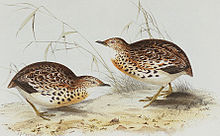Common Buttonquail
| Kurrichane Buttonquail | |
|---|---|
 | |
| Conservation status | |
 Least Concern (IUCN 3.1) | |
| Scientific classification | |
| Kingdom: | Animalia |
| Phylum: | Chordata |
| Class: | Aves |
| Order: | Turniciformes |
| Family: | Turnicidae |
| Genus: | Turnix |
| Species: | T. sylvaticus |
| Binomial name | |
| Turnix sylvaticus Desfontaines, 1789 | |
The Kurrichane Buttonquail, Small Buttonquail, Common Buttonquail, or Andalusian Hemipode (Turnix sylvaticus) is a buttonquail, one of a small family of birds which resemble, but are unrelated to, the true quails. This species is resident from southern Spain and Africa through India and tropical Asia to Indonesia.
This tiny buttonquail is notoriously difficult to see. It is a small 15 cm long drab running bird, which avoids flying. It is a species which inhabits warm grasslands or scrub jungle and feeds on insects and seeds.
Small Buttonquail resembles a Common Quail. It has streaked sandy brown upperparts, buff underparts with black flank markings and a plain face. In flight, a whitish wingbar contrasts with the grey wing. Sexes are similar, but immature birds are more spotted below.
The female initiates courtship and builds the ground nest. The male incubates the normally four speckled greyish eggs, and tends the young, which can run as soon as they are hatched. The nesting season is June to September. The nest is a slight pad of grass placed in a natural hollow in the ground where it is usually tucked away amongst the stems of a tuft of grass. Very occasionally the grass is bent over it in a sort of canopy.
The female calls with a deep hoom-hoom-hoom and the male replies kek-kek-kek.
Widespread throughout its large range, the Small Buttonquail is evaluated as Least Concern on the IUCN Red List of Threatened Species.
Avoids thick forest and hilly country, and lives by preference in cornfields and stretches of grassy plain though it may also be found in any type of low herbage and open scrub jungle. It skulks and is flushed with difficulty, rising often close by one's feet. When flushed it flies low over the ground and soon settles again, after which it is very difficult to put up a second time.

No comments:
Post a Comment